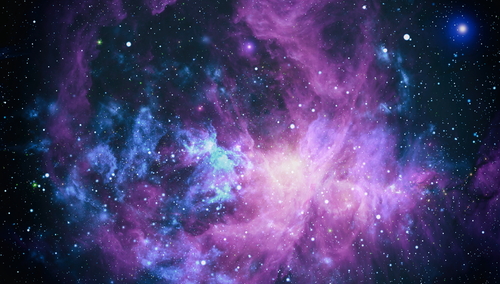Small Galaxy Pairs May Fuel Star Birth In Their Larger Neighbors, Finds New Study
Astronomers discovered that pairs of small colliding galaxies can feed their larger neighbors with gas, thereby nourishing star formation in other galaxies.
Astronomers have uncovered that small galactic mergers can play an important part in fueling larger galaxies with gas, providing them with precious material that goes into the making of stars.
The finding belongs to a team of scientists from several U.S. universities, as well as Germany and Canada, who studied a pair of dwarf galaxies, simulating their collision in a computer model.
The experiment revealed that small galactic mergers create a rich reserve of gas, which can linger in space for billions of years and cover vast distances to reach larger galaxies that would immediately gobble it up, reports Science Daily.
The research, published last week in the journal Monthly Notices of the Royal Astronomical Society, could help us understand how larger galaxies, such as our own, can trap gas from their satellite galaxies and use it to replenish their star-birthing material and give rise to even more new stars.
The Milky Way itself has its very own satellite galaxies, in the shape of the Magellanic Clouds. According to Science Daily, which cites New York City’s Columbia University, the Small Magellanic Cloud and the Large Magellanic Cloud were on the verge of collision when they became entrapped by our galaxy’s gravitational pull. Had they crashed into one another, they would have unleashed “enough gas to replenish half of the Milky Way’s supply of star-making fuel,” notes the university.
The astronomers reached their conclusions after looking into the case of NGC 4490 and NGC 4485, a pair of distant dwarf galaxies that sit 23 million light-years from Earth, in the constellation Canes Venatici (“Hunting Dogs”). The pair was chosen due to its remoteness, which meant that the astronomers could model its collision in the absence of any interference from a larger galaxy.
At the same time, “this system is an isolated analog of the Magellanic Clouds,” the authors wrote in their paper.
Just like the Large Magellanic Cloud, NGC 4490, also known as the Cocoon Galaxy, is several times larger than its sibling and is a starburst galaxy. This makes the dwarf galaxies excellent candidates for the study of what might happen in the case of a collision between Milky Way’s satellites.
The two dwarf galaxies are currently just interacting with each other, something which has distorted their shape and increased their star productivity. Yet the computer simulation ran by the astronomers unveiled that it wouldn’t take long for NGC 4490 to start syphoning gas from its smaller companion in the case of an impending collision.
A merger between NGC 4490 and NGC 4485 would create a continuously expanding cloud of gas, shows the new study, documenting that their gas tail would linger for 5 billion years and grow to measure 1 million light-years in length.
“After 5 billion years, 10 percent of the gas envelope still resides more than 260,000 light-years from the merged remnant, suggesting it takes a very long time before all the gas falls back to the merged remnant,” said study lead author Sarah Pearson, a fellow at the Flatiron Institute’s Center for Computational Astrophysics.
This suggests that the displaced gaseous material floating around in space would be up for grabs if it happened to waft by any large galaxy.
“You have this enormous reserve of star formation fuel sitting there, ready to be stripped by another system,” says study co-author Mary Putman, an astronomer at Columbia University.
According to Pearson, who was a Columbia graduate student when she conducted the research, more such pairs of dwarf galaxies populate the cosmos.
“Our study suggests that similar dwarf pairs exist out there. Because their gas is so extended, if they fall into something like the Milky Way, their gas is easily shed.”

